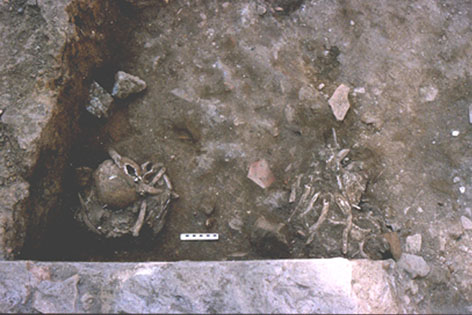
 |
Two groups of human bones found in the fill of a pit outside the west end of the mill. |
Traces of another siege of Rome, this time in 1849, may also be represented by a disturbed area immediately outside the mill. Here (upstream) the vault of the aqueduct has been completely destroyed, apparently by a large crater or pit. The lower part of this is filled with rubble from the aqueduct vault and walls, with much pottery and tile; the upper part contained large quantities of debris and pottery, some dated as late as the 18th and 19th centuries, together with a lead bullet and two deposits of human bones. The bones, tightly grouped as though they had been deposited in bags or sacks, represented parts of at least two individuals (a cranium, a jawbone and parts of a second jawbone were found), but they were clearly redeposited, and were not original burials. The explanation for their presence is unclear, but the dating evidence would permit the hypothesis that the pit which has destroyed the aqueduct's vault is a shell crater from the siege of 1849 (when this area came under heavy fire), and that the bones were victims of the siege, disturbed during the extensive landscaping works preparatory to the sale and redevelopment of the area in the 1880s, when the pit or crater was perhaps filled in.
The excavations within the Academy's car park have therefore illustrated two aspects of the long-term urban infrastructure of ancient Rome, the water-supply and the food-supply, conjoined with one and perhaps two dramatic events in the history of the defence of Rome, at a strategically important point just inside the line of the city walls
| Next | Previous | Home |
Go to:
Other Links: